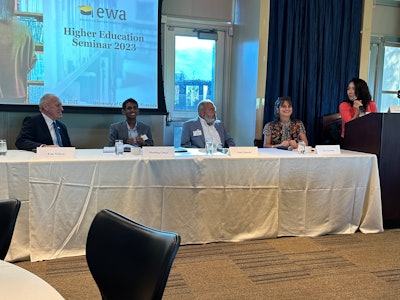RIVERSIDE, Calif--
As Americans express increasing skepticism about the value of higher education, how much colleges contribute to social mobility has come into the spotlight. With student debt spiraling out of control, people are increasingly interested in examining whether the tuition really pays off in terms of economic benefits. In recent years, the U.S. News and World Report has added measures of social mobility to its college rankings, and the Carnegie Foundation is currently looking into how social mobility can be incorporated into its all-important classification system. Suddenly, social mobility is getting the attention that it has long deserved.
With this as a backdrop, the Education Writers Association gathered a panel of experts to discuss social mobility as part of its annual Higher Education Seminar, hosted at the University of California, Riverside. It was clear that social mobility is increasingly important, but the best ways that colleges can help students achieve it and the best ways that it can be measured and communicated were less certain.
 The panel on social mobility at the University of California, Riverside.
The panel on social mobility at the University of California, Riverside.
“Higher education is coming back to its roots and recognizing its actual mission,” he said.
How social mobility is measured can lead to wildly different results, however. Dr. Kim A. Wilcox, chancellor of the University of California, Riverside, noted that his school’s rankings in the U.S. News and World Report and Washington Monthly are significantly different. U.S. News has had Riverside as the top-ranked school for social mobility for several years running, but in Washington Monthly, Riverside was #40.
Glastris said that there are many valid ways to measure mobility, and that Washington Monthly was reliant on federal data. The factors that it uses include student earnings, student capacity to pay off debt, and comparing the percentage of students who receive Pell grants that graduate to the expected rates.
Mushtaq Gunja, executive director of the Carnegie Classification system and senior vice president of the American Council on Education, said that measuring social mobility is complex, involving many variables. A school might be offering access to a great many low-income students, but not graduating many of them. Or vice-versa. He said that although Carnegie was doing well with measuring economic mobility, social mobility itself was more of a struggle.
Dr. Zoe Corwin, a research professor at the University of Southern California Rossier School of Education and principal investigator for the Promoting At-Promise Student Success Project, agreed that measuring social mobility can be problematic. A lot of the time, she said, it is viewed in terms of students moving away from their home communities, but in reality, a lot of students feel driven to stay.
Gunja also raised issues with the nature of rankings themselves. He said that they can lead to false precision, the incorrect idea that the #75 institution, for example, is meaningfully better than the #90 institution. He also argued that institutions that are very different are being unfairly compared. He cited geographic differences as a particular sore spot.
“$50,000 in Mississippi is different from $50,000 in Silicon Valley,” he said.
Glastris, on the other hand, defended rankings as useful.
“It’s how human beings do everything,” he said. “It’s how you communicate quickly in a way that everyone understands. Stories are silly too in many ways, but we all tell stories.”
He said that Washington Monthly attempts to account for geographical differences by using average home values to balance against a student’s earnings, but admitted that it was probably insufficient.
Moderator Teresa Watanabe of the Los Angeles Times asked the panel what schools that had been successful with social mobility had been doing—was there some sort of secret sauce to it? The panel didn’t think that there was any one easy answer, but Wilcox emphasized culture, people, and programs, in that order. Establishing an environment that’s friendly to low-income students of various stripes will lead them to attend, at which point programs to help them can be established.
Creating that environment is easier said than done, but Glastris agreed that it was the critical factor that linked successful schools.
“Schools that are helping average students get ahead is what higher education is about,” he said.
And although figuring out how to help students move up in class is difficult, it’s important work.
“Any attempt to grapple with this is worthwhile,” said Glastris.
Jon Edelman can be reached at [email protected]





















